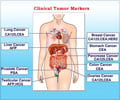A second molecular pathway may need to be blocked to prevent malignant cells from creating new blood vessels [angiogenesis], researchers have found
A second molecular pathway may need to be blocked to prevent malignant cells from creating new blood vessels [angiogenesis], researchers at the University of California Los Angeles (UCLA) have found.
A study of patients with pancreatic cancer showed that CXCL5 may be a key molecule in the angiogenesis switch-the point at which cells stop being normal and start producing blood vessels that feed malignancy. Findings from the study were presented at the 2009 Clinical Congress of the American College of Surgeons.CXCL5 is one member of a family of molecules that may play a role in the development of future anti-angiogenesis treatments. "CXC peptides have been shown to cause cancer cells to multiply and migrate and tumors to form new blood vessels. With data from this study as well as other studies, we''re showing that we need to pay attention to the CXCL5 molecule because there appears to be multiple pathways driving tumor angiogenesis," according to Jonathan C. King, MD, a surgical resident at UCLA.
The study showed that patients who had high levels of CXCL5 were more likely to have cancer at a more advanced stage, more poorly differentiated and therefore more aggressive tumors, and greater density of small tumor blood vessels than those who had low levels of the molecule.
The patients also were far more likely to die quickly from the disease. Patients whose tumors had low levels of expression of CXCL5 lived 25.5 months longer than those whose tumors had high levels of expression of the molecule. "Patients who express a lot of CXCL5 in their tumors have significantly decreased survival overall, and part of the reason may be that the tumors are better able to promote angiogenesis than the high-CXCL5-producing tumors," Dr. King said.
In addition, the researchers found that lesions considered to be immediate precursors of pancreatic cancer [pancreatic intraepithelial neoplasia or PanIN] were more likely to express higher levels of CXCL5 using laboratory staining techniques. "PanIN were found to stain more intensely along the spectrum from dysplasia [abnormal cellular growth] to malignancy [uncontrolled new growth]. So a low-grade PanIN lesion had little to no CXCL5 expression, while the high-grade lesions had relatively high expression of the molecule," Dr. King explained. This finding provides further support for the theory that CXCL5 may be involved in the angio- genic switch. "When CXCL5 is expressed may be an important stage in the development of cancer," he added.
Although the study examined clinical data and surgical specimens from 153 patients with pancreatic cancer, the action of the CXCL5 molecule is not specific to this form of malignancy. "CXCL5 is a molecule that is released from all kinds of solid tumors that require new blood vessel formation to grow. The application [of CXCL5 as a target of angiogenesis therapy] is potentially far broader than for just pancreatic cancer," Dr. King said.
Results from the study are leading researchers to take a whole new look at angiogenesis and its molecular contributors. Vascular endothelial growth factor (VEGF) has been the principal focus of angiogenesis research because of its strong links to the process of generating new blood vessels by malignant cells. Treatments directed against the action of VEGF have not favorably influenced the survival of patients with pancreatic cancer, however. UCLA and other researchers therefore have been exploring whether other molecules besides VEGF are enabling tumors to grow new blood vessels. "Drs. Li and Hines have focused on CXCL5, but there are other CXC molecules-CXCL8 and CXCL1-that are pro-angiogenic. If we can target these molecules along with VEGF, the thought is that treatment against angiogenesis would be more powerful than targeting one of the molecules alone," he added.
RAS
 MEDINDIA
MEDINDIA




 Email
Email






